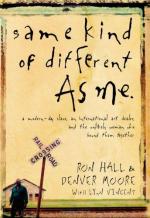|
This section contains 624 words (approx. 2 pages at 400 words per page) |

|
Same Kind of Different as Me: A Modern-Day Slave, an International Art Dealer, and the Unlikely Woman Who Bound Them Tog Summary & Study Guide Description
Same Kind of Different as Me: A Modern-Day Slave, an International Art Dealer, and the Unlikely Woman Who Bound Them Tog Summary & Study Guide includes comprehensive information and analysis to help you understand the book. This study guide contains the following sections:
This detailed literature summary also contains Topics for Discussion on Same Kind of Different as Me: A Modern-Day Slave, an International Art Dealer, and the Unlikely Woman Who Bound Them Tog by Ron Hall (author).
The following version of this book was used to create this study guide: Hall, Ron. Same Kind of Different as Me. Thomas Nelson Inc., 2006.
The novel is told from two perspectives: Ron Hall, a rich white art dealer, and Denver Moore, a black homeless man. The story is told in the first-person, past tense.
Denver Moore was born on a cotton plantation in the middle of the twenthieth century. He was poor, raised by different family members, and worked for white plantations owners because of racist systems that kept him ignorant. Ron Moore also grew up on a cotton plantation but he had a positive experience because of his white skin. As Denver related how his family members died, Ron was privileged enough to go to college where he became materialistic.
Ron married a Christian woman, Deborah, and they raised a family. Ron quit a modest banking job to pursue a career as an art dealer. He had massive success. As Deborah pursued spiritual matters, Ron pursued wealth. The couple grew distant and Ron had an affair. Instead of divorcing Ron, Deborah chose to work on their marriage and put her faith in the church. Years later, their marriage was stronger than it ever had been because of their renewed faith. Deborah convinced Ron to volunteer at a homeless shelter. Ron secretly detested homeless people but he agreed to appease his wife.
During the years Ron pursued wealth, Denver left the cotton plantation and hitched a train to Dallas. He ended up on the streets where he turned to drugs and alcohol. Denver committed robbery out of necessity, which landed him in prison for ten years. He went back to the streets afterward. Denver got a reputation as a mean and violent homeless man, but it was just a survival mechanism. He patronized the homeless mission where Ron and Deborah volunteered.
Inspired by a verse in the Bible, Deborah had a dream that they were fated to meet a poor and wise man. She decided that man was Denver. Deborah pushed Ron to befriend Denver. Although neither man wanted to spend time with each other at first, they learned to open up. Denver taught Ron to stop valuing material things and Ron taught Denver to trust again. Ron realized that Denver seemed to possess prophetic abilities. He was alarmed when Denver warned that Satan would come for Ron’s wife because she was valuable to God. Deborah was diagnosed with cancer. Ron prayed to God, certain that Deborah would be healed because they were good Christians. All operations failed and Ron had a crisis of faith. Denver helped Ron accept there were things he could not change. During this time, Ron and Denver became closer. Ron trusted Denver to deliver valuable equipment in his car, but worried the homeless man would steal from him. Denver did not steal from Ron and their friendship was cemented. Deborah accepted her impending death with grace after months of suffering. Before she died, Deborah and Denver experienced the same visions. Ron believed God was speaking through both of them. Deborah died. Ron, his family, Denver, and all those Deborah touched gave her an emotional funeral.
Ron still suffered from a crisis of faith, but Denver helped him through it. A wealthy benefactor commemorated Deborah by naming a new homeless mission after her. Denver and Ron decided to write a book about their experiences. They traveled to Denver’s old cotton plantation, where Ron witnessed the squalid and impoverished conditions Denver used to live in. Ron and Denver became best friends, attending George W. Bush’s inauguration together in 2005. Although Ron still felt resentment toward God, he championed his Christian faith in the work’s final passages.
Read more from the Study Guide
|
This section contains 624 words (approx. 2 pages at 400 words per page) |

|



